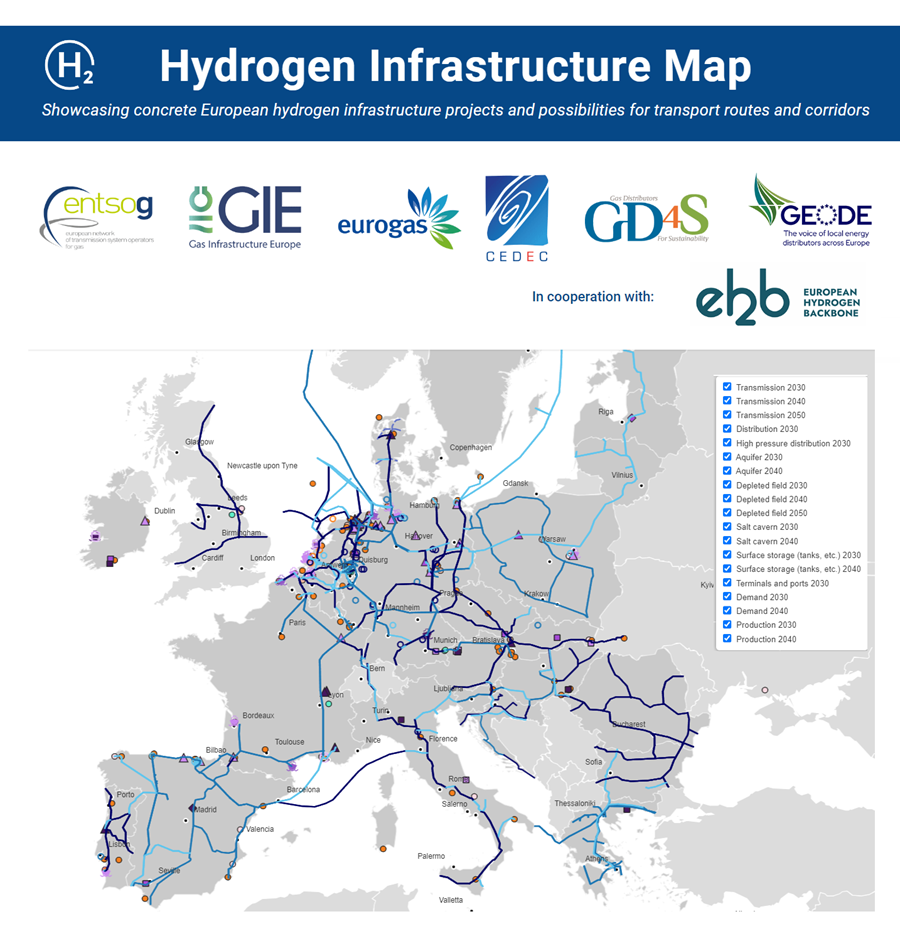November 16, 2023
Today, the latest edition of the joint interactive map by ENTSOG, GIE, Eurogas, CEDEC, GEODE, GD4S (in cooperation with the European Hydrogen Backbone Initiative) has been published. This updated map displays the status of planned hydrogen projects in 2030, 2040 and 2050 and spans hydrogen projects for gas distribution, transmission, import terminals, storage, demand and production.

“On the cusp of the Hydrogen and Decarbonised Gas Market Package being finalised, frequent map updates are essential to reflect the good advancements being made by hydrogen project promoters to decarbonise their activities”
A total of 91 new projects were submitted for this edition, across all parts of the hydrogen infrastructure value chain. Approximately two thirds of those projects submitted represent hydrogen demand and production. The involved associations are committed to facilitating updates to the Hydrogen Infrastructure Map twice a year, to ensure that it is a ‘living’ map comprising the most up-to-date status of the hydrogen projects network.
This edition of the map includes more than:
The update shows that infrastructure is an enabler in developing the hydrogen economy, and is not a bottleneck if deployed on scale and in time with proper support for the project promotors.
Repurposing the existing infrastructure is key to connecting hydrogen supply and demand clusters to create a pan-EU Hydrogen Backbone and will provide for decarbonisation at local level and enable the EU-wide trades.
Hydrogen storage is an essential technology required for the emergence of a RES-based future and hydrogen ecosystem. The terminals and ports are key to facilitate imports of hydrogen and its derivatives when the EU-made volumes would not cover the emerging demand.
Connections between the hydrogen distribution and transmission system are an immediate opportunity to create synergies among sectors at a local level, while providing for their security of supply and increasingly liquid markets for the hydrogen consumers.
The map also satisfies the European Commission’s request to visualise “all hydrogen infrastructure projects collected under different existing processes in a form of a map” in their conclusions at the 36th European Gas Regulatory Forum in May 2022.
The next update of the map is planned for Q2 2024.
Read more about the Hydrogen Infrastructure map here:
https://www.h2inframap.eu/.
In case of any questions, we invite you to contact info@H2inframap.eu.
> About CEDEC: CEDEC is the European Federation of local energy companies, representing the interests of 2000 local and regional energy and broadband companies across Europe, serving 100 million electricity, gas and district heating customers and broadband connections. Active in every part of the value chain – generation, distribution grids and supply – these companies provide services which are reliable, sustainable and close to the consumer, making a significant contribution to local and regional economic development.
> About ENTSOG: The European Network of Transmission System Operators for Gas was founded in line with Regulation (EC) 715/2009 and has played a key role in facilitating integration of the European gas markets, ensuring technical interoperability and providing security of supply by gas infrastructure planning. Looking forward, ENTSOG is contributing to the net-zero decarbonisation by 2050, in particular, by the integration of renewable and low carbon gases via future-proof gas transmission pipelines, in line with the EU energy and climate goals. More information on ENTSOG can be found on our website – www.entsog.eu or contact info@entsog.eu.
> About Eurogas: is an association of 76 companies and associations. Our members cover gas wholesale and retail gas markets, and the distribution of natural gas, biomethane and hydrogen. Eurogas also works with companies active on gases for vehicles, and on value chain methane emissions management. Eurogas accelerates the transition to carbon neutrality through dialogue and advocacy about optimising the use of gases. https://www.eurogas.org/
> About GD4S: Gas Distributors for Sustainability represents the leading natural gas distributors in France, Greece, Italy, Ireland, Spain, Portugal, the Netherlands and Romania. Together, we represent almost 35 million customers in Europe (more than 30% of the European market). Gas distributors are responsible for operating the gas distribution network, ensuring its maintenance, and its development. We are responsible for safely distributing natural and renewable gas to consumers.
> About GEODE: GEODE is a European association representing local energy companies operating electricity and gas distribution networks committed to a sustainable, efficient and reliable management of the grids as the backbone of the energy system. Thanks to the technical expertise of its members, GEODE’s mission is to accomplish the energy transition towards decentralised, decarbonised and digitalised energy systems.
> About GIE: Gas Infrastructure Europe (GIE) is the association representing the interests of European gas infrastructure operators. GIE members are active in transmission, storage and regasification via LNG terminals of renewable and low-carbon gases, including natural gas and hydrogen. Gathering around 70 industry entities from 27 European countries, GIE perfectly embodies the multiple transitional decarbonisation pathways of the EU regions. The association’s vision is that by 2050, the gas infrastructure will be the backbone of the new innovative energy system, allowing European citizens and industries to benefit from a secure, efficient and sustainable energy supply.
Gas Infrastructure Europe (GIE) is the association representing the interests of European gas infrastructure operators active in gas transmission, gas storage and Liquefied Natural Gas (LNG) regasification. GIE is a trusted partner of European institutions, regulatory bodies and industry stakeholders. It is based in Brussels, the heart of European policymaking. GIE currently represents 70 member companies from 26 countries. GIE’s vision is that by 2050, the gas infrastructure will be the backbone of the new innovative energy system, allowing European citizens to benefit from a secure, efficient and sustainable energy supply.
Downloads
















































